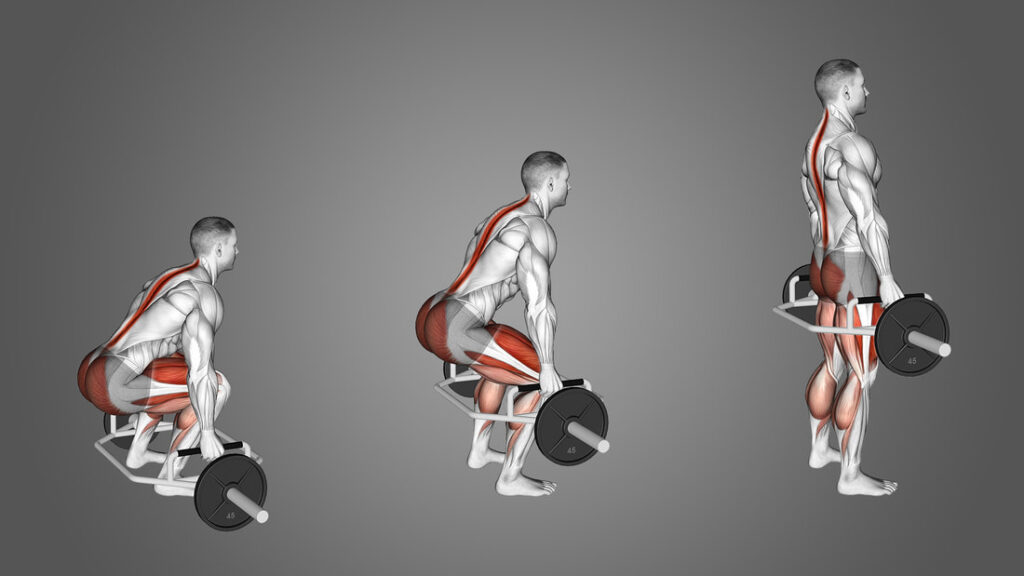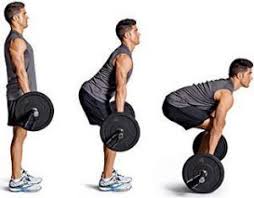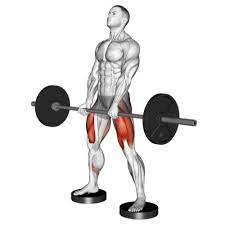

Forward head posture (FHP) is an all-too-common problem today, especially among people who spend long hours hunched over desks or mobile screens.
This condition can lead to neck pain, headaches, and even spinal issues if not corrected. While exercises like chin tucks and posture corrections are often recommended, could deadlifts — a classic strength training movement — be an effective solution for fixing FHP?
This article will explore how deadlifts can help correct forward head posture, the role of proper form, and how deadlifts can improve posture overall.
We shall also dive into insights from experts like Stuart McGill and examine specific cases, such as performing deadlifts with conditions like spondylolisthesis and spinal stenosis.
“How to Fix Forward Head Posture with Deadlifts” Article Index:
- Understanding Forward Head Posture and its Impact
- How Deadlifts Help Improve Forward Head Posture
- Stuart McGill’s Insights on Deadlifts and Posture
- Deadlifts for Those with Spondylolisthesis and Spinal Stenosis
- Correct Deadlift Posture: Why It Matters for Forward Head Posture
- How Deadlifts Improve Posture: Evidence and Research
- FAQs on Fixing Poor Neck Posture with Deadlifts
- Can Deadlifts Really Fix Forward Head Posture?
Understanding Forward Head Posture and its Impact
Forward head posture occurs when your head protrudes ahead of your body’s centerline, putting immense strain on the neck, shoulders, and upper back.
This misalignment can lead to increased pressure on the cervical spine, often resulting in pain, muscle fatigue, and a weakened upper body posture.
It is essential to correct FHP before it leads to long-term spinal problems, including poor muscle function and chronic neck issues.
How Deadlifts Help Improve Forward Head Posture
Deadlifts, when performed correctly, can have a powerful effect on your posture by strengthening the posterior chain — the group of muscles that run from the back of your head down to your heels.
The posterior chain, especially the muscles in the back and glutes, plays a key role in maintaining proper spinal alignment.
Strengthening these muscles through deadlifts not only stabilizes the spine but also pulls the head back into alignment with the body, helping to correct forward head posture.
According to research by Stuart McGill, a prominent spinal biomechanics expert, deadlifts are one of the best exercises for building core strength and reinforcing spinal stability.
McGill’s work suggests that deadlifts help develop the muscles that support the spine and improve overall posture. However, McGill emphasizes that maintaining the correct deadlift posture is crucial to avoid injury and maximize benefits.
Stuart McGill’s Insights on Deadlifts and Posture
Stuart McGill deadlift techniques focus on a neutral spine, which is critical for both lifting safely and correcting posture.
McGill’s approach stresses the importance of maintaining proper alignment during deadlifts to reduce strain on the neck and back.
Forward head posture often results from a weakened posterior chain, and deadlifts, by targeting the back, glutes, and hamstrings, can gradually pull the shoulders and head back into a more neutral position.
McGill advises lifters to maintain a neutral neck position while lifting to prevent exacerbating forward head posture. This means keeping the head aligned with the spine and avoiding looking too far upward or downward while performing the deadlift.
By doing so, you engage the muscles that support the spine, reinforcing better head and neck posture.
Deadlifts for Those with Spondylolisthesis and Spinal Stenosis
For individuals with pre-existing spinal conditions, such as spondylolisthesis or spinal stenosis, deadlifts can still be beneficial for posture correction, but with modifications and caution.
Spondylolisthesis and Deadlifts:
Spondylolisthesis refers to the forward displacement of a vertebra, which can make traditional deadlifts risky due to the strain they can place on the lower back.
However, modified deadlifts, such as Romanian deadlifts or trap bar deadlifts, can offer the same benefits while minimizing strain on the affected vertebrae.
These variations engage the posterior chain without exacerbating the condition, making them effective for improving posture without compromising spinal health.
Spinal Stenosis and Deadlifts:
In cases of spinal stenosis, where the spinal canal narrows and puts pressure on the nerves, traditional deadlifts may be uncomfortable or even harmful.
Still, exercises that focus on hip hinging and lower back stability, like sumo deadlifts or rack pulls, can help strengthen the muscles that support the spine.
These variations reduce the load on the lower back while still engaging the posterior chain, which is essential for correcting forward head posture.
Correct Deadlift Posture: Why It Matters for Forward Head Posture
The correct deadlift posture is critical for maximizing the benefits of the exercise while minimizing the risk of injury. Proper form ensures that the spine remains neutral throughout the lift, avoiding excess strain on the neck and back.
This neutral spine position naturally helps in improving posture, especially for those suffering from forward head posture.
Key points to maintain correct deadlift posture include:
- Keeping the head aligned with the spine, not looking up or down.
- Engaging the core and glutes to support the lower back.
- Maintaining a slight bend in the knees, with the hips driving the movement.
By practicing posture for deadlift correctly, you activate the muscles necessary for spinal stabilization, which directly contributes to better overall posture, including pulling the head back into alignment with the shoulders.
How Deadlifts Improve Posture: Evidence and Research
Research shows that deadlifts improve posture by strengthening the muscles responsible for spinal alignment.
A study published in the Journal of Strength and Conditioning Research found that individuals who performed deadlifts regularly exhibited significant improvements in both static and dynamic posture.
This included correcting forward head posture, as the back muscles became more developed and capable of pulling the head into a neutral position.
Another study highlighted the role of deadlifts in reducing upper body fatigue, which often contributes to poor posture.
By increasing strength and endurance in the posterior chain, deadlifts help individuals maintain better posture throughout the day, even when sitting for extended periods. This can lead to long-term improvements in posture and reductions in neck pain and tension headaches.
FAQs on Fixing Poor Neck Posture with Deadlifts
Forward head posture (FHP) occurs when the head protrudes forward from the body’s centerline, often due to prolonged periods of looking down or slouching. This misalignment can lead to neck strain, headaches, and other discomforts.
Incorporating deadlifts into your exercise routine, with proper technique, can help correct FHP by strengthening the muscles that support the neck and upper back.
Here are six unique FAQs on how to fix forward head posture with deadlifts:
Q1: How does performing deadlifts with proper form help correct forward head posture?
A1: Executing deadlifts with correct form strengthens the posterior chain, including the upper back and neck muscles. This strengthening helps pull the shoulders back and aligns the head over the spine, counteracting the forward head position. Maintaining a neutral neck position during deadlifts also reinforces proper posture habits.
Q2: What are the key deadlift form cues to prevent exacerbating forward head posture?
A2: To prevent worsening FHP during deadlifts:
Neutral Neck Position: Keep your head aligned with your spine by gazing forward or slightly down, avoiding craning your neck up or down.
Engage the Upper Back: Retract your shoulder blades to activate the upper back muscles, promoting proper posture.
Maintain a Flat Back: Ensure your spine remains neutral throughout the lift to prevent additional strain on the neck.
Q3: How can deadlifts be modified to accommodate individuals with tight neck muscles due to forward head posture?
A3: For those with tight neck muscles:
Use Lighter Weights: Start with manageable weights to focus on form and reduce strain.
Incorporate Mobility Exercises: Before deadlifting, perform neck stretches and mobility exercises to alleviate tightness.
Gradual Progression: Increase weight and intensity slowly to allow the neck muscles to adapt without overexertion.
Q4: How often should deadlifts be incorporated into a routine to see improvements in forward head posture?
A4: Incorporating deadlifts into your routine 2-3 times per week, with proper form, can lead to noticeable improvements in posture. Consistency is key, and combining deadlifts with other corrective exercises, such as chin tucks and thoracic spine mobility work, can enhance results.
Q5: Are there other exercises that complement deadlifts in correcting forward head posture?
A5: Yes, exercises that strengthen the upper back and neck muscles, such as face pulls, band pull-aparts, and chin tucks, can complement deadlifts. These exercises target the deep cervical flexors and upper trapezius, further promoting proper head alignment.
Q6: Can improper deadlift technique worsen forward head posture?
A6: Yes, improper deadlift technique, such as craning the neck up or down, can exacerbate forward head posture. It’s crucial to maintain a neutral neck position during the lift to prevent additional strain and support proper spinal alignment.
By integrating deadlifts with correct form and combining them with targeted exercises, individuals can effectively address and correct forward head posture, leading to improved neck health and overall posture.
Can Deadlifts Really Fix Forward Head Posture?
In conclusion, deadlifts can play a significant role in fixing forward head posture by strengthening the posterior chain and pulling the head back into proper alignment.
According to bestforwardheadposturefix.com, “it is essential to perform deadlifts with the correct deadlift posture to avoid injury and maximize their benefits”.
Modifications may be necessary for those with conditions like spondylolisthesis or spinal stenosis, but even in these cases, deadlifts can be a powerful tool for improving posture and spinal health.
Deadlifts alone may not entirely correct forward head posture, but they are a crucial part of a comprehensive strength and posture improvement routine.
Combining deadlifts with targeted exercises for the neck and upper back can provide lasting results, helping you stand taller and reduce neck strain.
So, yes, deadlifts can help fix forward head posture — just make sure you are lifting with the proper form and technique.
References:


